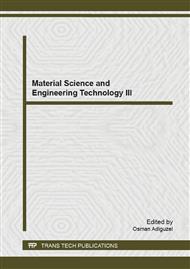p.62
p.66
p.70
p.75
p.79
p.85
p.89
p.93
p.99
Thermal Property Evaluation of Chilled Aluminum-Alumina MMC
Abstract:
Now a day’s composite materials are taking very important role in industrial growth. Composite materials are widely used in Automobiles, aerospace, submarine and also in other major fields, due to their special characteristics like light weight, high strength, stiffness, corrosion resistance. The determination of Coefficient of Thermal Expansion (CTE) of MMCs is important to aid its usage in high temperature environment as in the case of automobile combustion chamber. In these applications the stability of the composites over a long period of operation is a critical design considerationPresent work deals with the thermal property evaluation of the Al alloy / alumina metal matrix composite developed using the Stir Casting with chilling route technique. LM 26 Al alloy is being selected as the matrix material as it is a potential alloy for automotive piston applications. Al alloy / alumina MMCs was cast under end chilling technique by dispersing the reinforcement from 6 to 12 wt% the steps of 3% to study the variation in its thermal properties. At the same time chill material is also changed (Copper and MS) for different composition of MMCs cast to study the thermal behavior variations. After casting the required MMC, test specimens were prepared as per the standards to conduct thermal conductivity (K) tests and coefficient of thermal expansion (CTE) tests. Above tests were repeated for different composites containing different weight % of dispersed cast using different chills.
Info:
Periodical:
Pages:
79-82
Citation:
Online since:
April 2015
Authors:
Price:
Сopyright:
© 2015 Trans Tech Publications Ltd. All Rights Reserved
Share:
Citation:


